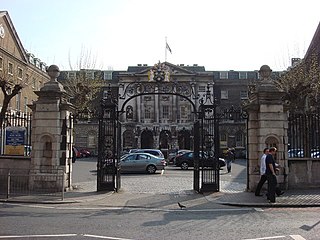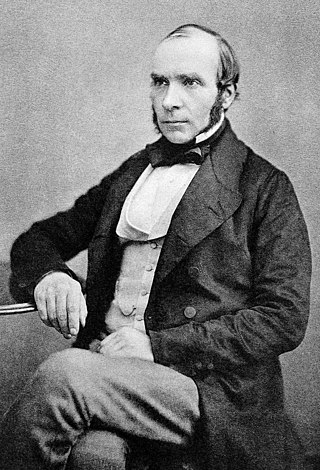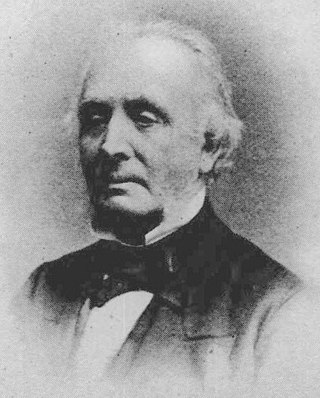Related Research Articles

Edward Jenner, was an English physician and scientist who pioneered the concept of vaccines and created the smallpox vaccine, the world's first vaccine. The terms vaccine and vaccination are derived from Variolae vaccinae, the term devised by Jenner to denote cowpox. He used it in 1798 in the title of his Inquiry into the Variolae vaccinae known as the Cow Pox, in which he described the protective effect of cowpox against smallpox.

The smallpox vaccine is the first vaccine to have been developed against a contagious disease. In 1796, British physician Edward Jenner demonstrated that an infection with the relatively mild cowpox virus conferred immunity against the deadly smallpox virus. Cowpox served as a natural vaccine until the modern smallpox vaccine emerged in the 20th century. From 1958 to 1977, the World Health Organization (WHO) conducted a global vaccination campaign that eradicated smallpox, making it the only human disease to be eradicated. Although routine smallpox vaccination is no longer performed on the general public, the vaccine is still being produced to guard against bioterrorism, biological warfare, and mpox.

Guy's Hospital is an NHS hospital in the borough of Southwark in central London. It is part of Guy's and St Thomas' NHS Foundation Trust and one of the institutions that comprise the King's Health Partners, an academic health science centre.

John Snow was an English physician and a leader in the development of anaesthesia and medical hygiene. He is considered one of the founders of modern epidemiology, in part because of his work in tracing the source of a cholera outbreak in Soho, London, in 1854, which he curtailed by removing the handle of a water pump. Snow's findings inspired the adoption of anaesthesia as well as fundamental changes in the water and waste systems of London, which led to similar changes in other cities, and a significant improvement in general public health around the world.
The Royal Medical and Chirurgical Society of London (RMCS), created in 1805 as the Medical and Chirurgical Society of London, was a learned society of physicians and surgeons, that received a Royal charter in 1834, and a supplement charter in 1907 to create the newly merged Royal Society of Medicine.

Edward Headlam Greenhow FRS, FRCP was an English physician, epidemiologist, sanitarian, statistician, clinician and lecturer.

Thomas Michael Greenhow MD MRCS FRCS was an English surgeon and epidemiologist.

Benjamin Guy Babington was an English physician and epidemiologist.

William Henry Corfield was an English public health physician. Appointed Professor of Hygiene and Public Health at University College London in 1869, Corfield had a major influence on public health and household sanitation in Victorian England before there was extensive knowledge of bacteriology and a clear understanding of infectious disease transmission. He was also an early advocate of land filtration and sewage farms.

The Hunterian Society, founded in 1819 in honour of the Scottish surgeon John Hunter (1728–1793), is a society of physicians and dentists based in London.
The Pathological Society of London was founded in 1846 for the "cultivation and promotion of pathology by the exhibition and description of specimens, drawings, microscopic preparations, casts or models of morbid parts."

Edmund Alexander Parkes was an English physician, known as a hygienist, particularly in the military context.
The Clinical Society of London was founded in London in 1868 and merged in 1907 with the Royal Medical and Chirurgical Society of London to form the Royal Society of Medicine (RSM).
The Milroy Lectures are given on topics in public health, to the Royal College of Physicians, London. They were set up by money left by Gavin Milroy, who died in 1886.

Joseph Frank Payne (1840–1910) was an English physician, known also as a historian of medicine.
Inoculation is the act of implanting a pathogen or other microbe or virus into a person or other organism. It is a method of artificially inducing immunity against various infectious diseases. The term "inoculation" is also used more generally to refer to intentionally depositing microbes into any growth medium, as into a Petri dish used to culture the microbe, or into food ingredients for making cultured foods such as yoghurt and fermented beverages such as beer and wine. This article is primarily about the use of inoculation for producing immunity against infection. Inoculation has been used to eradicate smallpox and to markedly reduce other infectious diseases such as polio. Although the terms "inoculation", "vaccination", and "immunization" are often used interchangeably, there are important differences. Inoculation is the act of implanting a pathogen or microbe into a person or other recipient; vaccination is the act of implanting or giving someone a vaccine specifically; and immunization is the development of disease resistance that results from the immune system's response to a vaccine or natural infection.

The Edward Jenner Medal is awarded occasionally by the Royal Society of Medicine to individuals who have undertaken distinguished work in epidemiological research.

Dr. Blasio Vincent Oriedo, in full Dr. Blasio Vincent Ndale Esau Oriedo was an African epidemiologist and a parasitological scientist known for his contributions to tropical medicine and work to stem disease epidemics in colonial and postcolonial Kenya, the countries of East and Central Africa, and the Sudan. He is credited for saving thousands of native African lives from infectious disease. Dr. Oriedo was a recipient of the Extramural Medical Research Grant presented by the US National Institutes of Health (NIH).
Walter Werner Holland was an epidemiologist and public health physician.

Francis Albert Rollo Russell was an English meteorologist and scientific writer. Russell was also an alternative cancer treatment advocate who promoted the idea that cancer is caused by excessive consumption of meat, alcohol, coffee and tea.
References
- 1 2 3 "Origin of London Epidemiological Society". UCLA. Retrieved 22 October 2012.
- ↑ "Royal Society of Medicine Records". 1907–1975. Archived from the original on 24 June 2023. Retrieved 24 June 2023.
- ↑ Parliamentary Papers, Volume 58. H.M. Stationery Office. 1861. p. 10.
REPORT on QUARANTINE by the Committee of the National Association for the PROMOTION of SOCIAL SCIENCE , with ... B.G. Babington, M.D., F.R.S, President of the Epidemiological Society .
- ↑ Transactions of the National Association for the Promotion of Social Science. John W. Parker. 1858. p. 348. Retrieved 29 June 2020.
Report from the Epidemiological Society followed by a miscellaneous paper from T. M. Greenhow: "Health; how preserved, how impaired".... [page 347] - Dr E Headlam Greenhow [T.M. Greenhow's nephew] delivers a paper on "Public Health Statistics"
- ↑ "Epidemiological Society". The Lancet, 28 May 1853: 540–542. doi:10.1016/S0140-6736(02)45741-8.
Epidemiological Society - Dr Edward Headlam Greenhow - IN THE CHAIR
{{cite journal}}: Cite journal requires|journal=(help) - ↑ "The influence of the London Epidemiological Society". Yale Journal of Biology and Medicine. 46 (1): 29–31. 1973. PMC 2591793 .
- ↑ "The Epidemiological Society of Great Britain Medal". Archives Hub. Retrieved 22 October 2012.